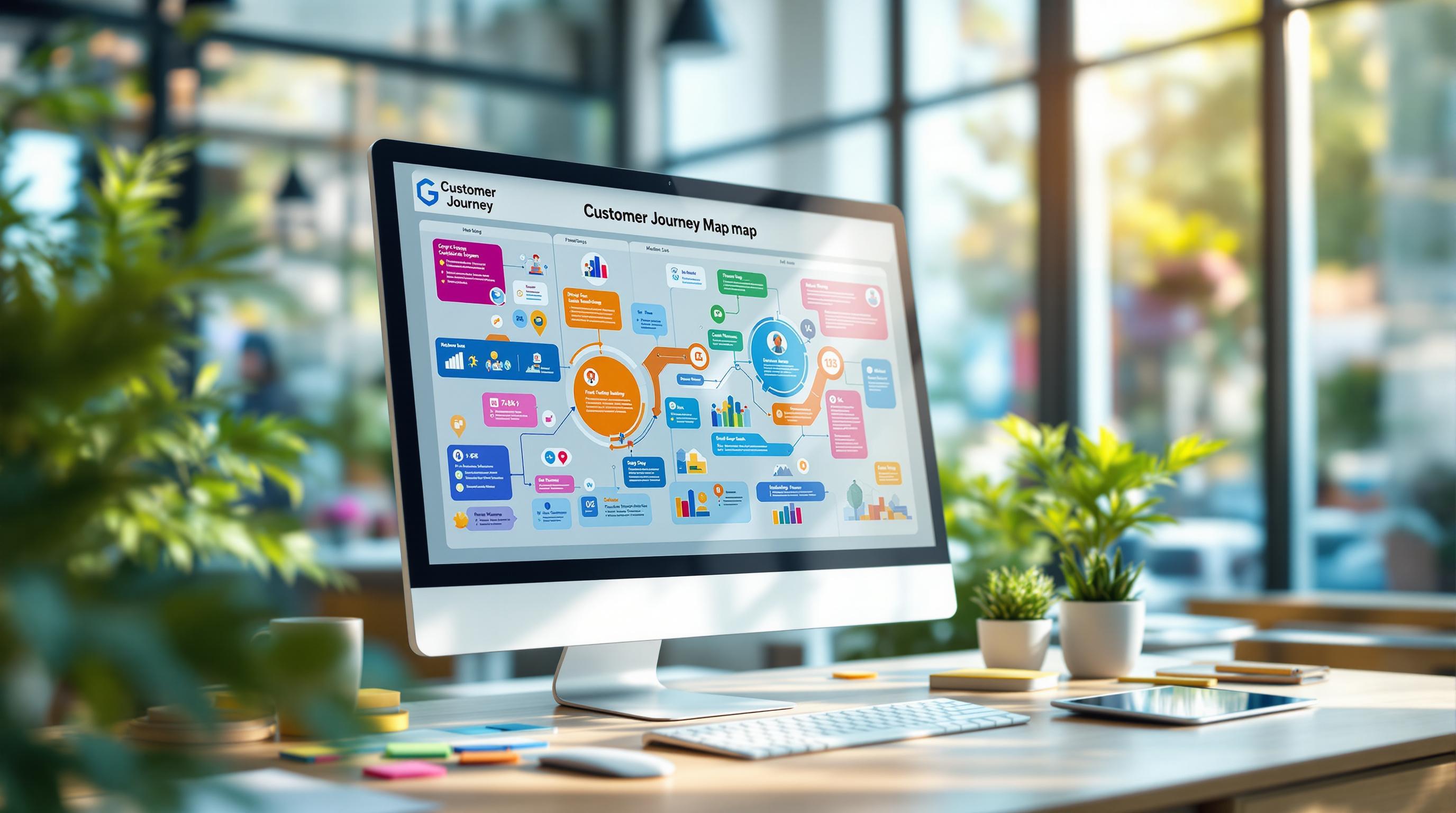Need to make faster, smarter decisions? Real-time business intelligence (RTBI) tools are essential for analyzing data instantly and adapting to changes on the fly. Companies like American Express and Florida Power and Light have saved millions using these tools, while marketers achieve up to 8x ROI with data-driven campaigns.
Here are the top 7 BI tools to help you harness real-time insights:
- Domo: Handles 100 trillion rows daily with over 1,000 pre-built connectors.
- Microsoft Power BI: Dominates the market with features like Automatic Page Refresh and AI-powered insights.
- Sisense: AI-powered platform delivering speed and embedded analytics.
- Qlik Sense: Uses an associative data model for dynamic, real-time exploration.
- Tableau: Provides live data visualizations and advanced integrations.
- Looker Studio: Google-based tool with seamless cloud integration.
- Zoho Analytics: Affordable, user-friendly, and connects directly to live data.
Quick Comparison
| Tool | Best For | Starting Price/User | Key Feature |
|---|---|---|---|
| Domo | Large-scale data processing | $20,000/year (Enterprise) | 1,000+ pre-built connectors |
| Power BI | Microsoft ecosystem | $14/month | Streaming datasets, AI insights |
| Sisense | Embedded analytics | Quote-based | In-chip processing engine |
| Qlik Sense | Free-form data exploration | $30/month | Associative data model |
| Tableau | Advanced data visualization | $75/month | Live connections, hybrid approach |
| Looker Studio | Google integrations | Free/$9 per project | Interactive dashboards |
| Zoho Analytics | Affordable real-time BI | $30/month | Live Connect for real-time data |
These tools empower businesses to analyze, adapt, and act in real time. Choose the one that aligns with your team's needs and start making smarter decisions today.
BI Analysis of BI Tools (The Most In-Depth Comparison of BI Tools)
1. Domo
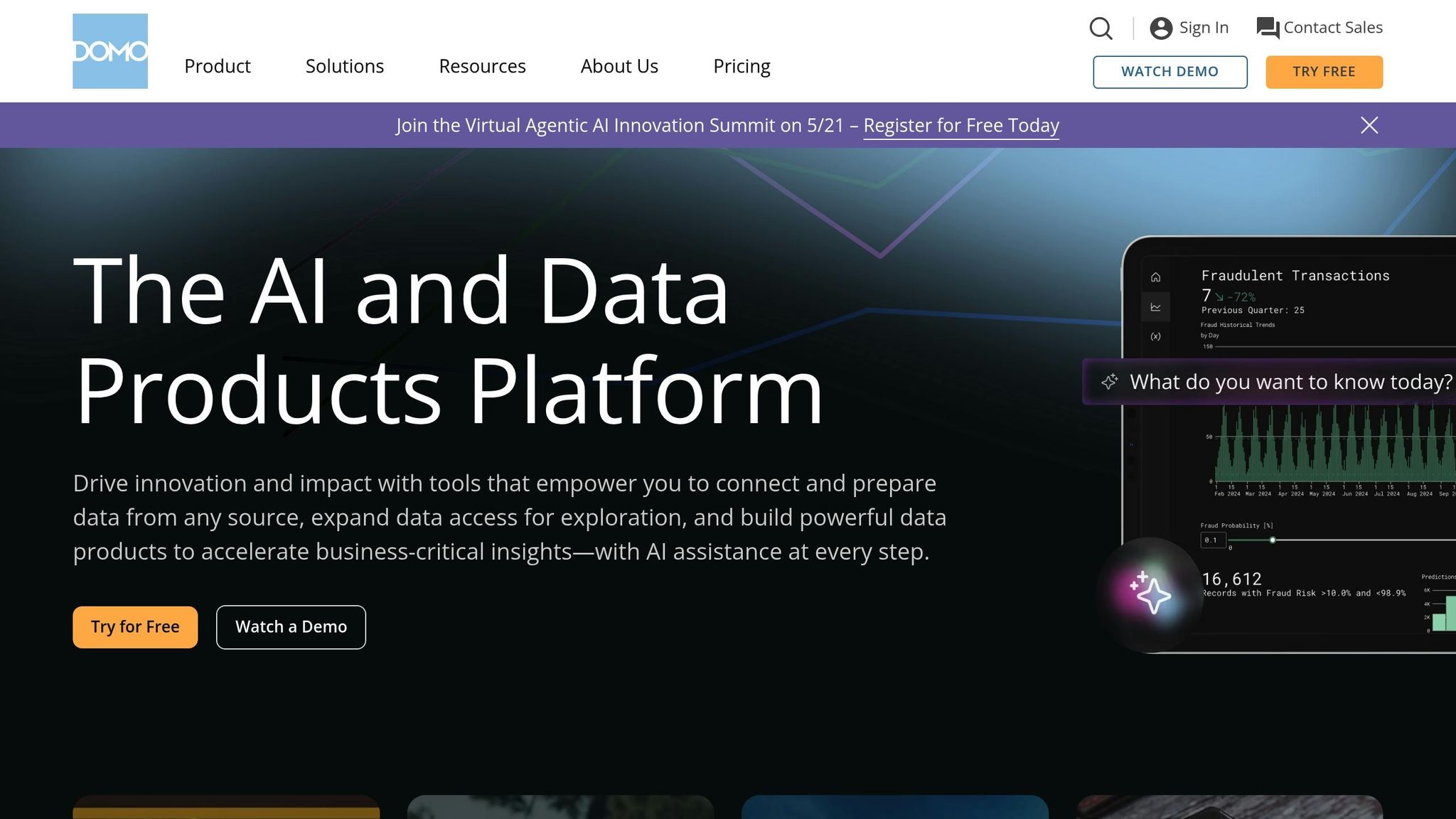
Domo is a cloud-based business intelligence (BI) platform designed to handle massive amounts of data - processing an impressive 100 trillion rows daily. Its real-time analytics tools turn raw data into actionable insights, helping businesses make smarter decisions faster.
The platform stands out with over 1,000 pre-built connectors, enabling seamless integration with cloud apps, on-premises systems, or custom APIs. For example, call centers can use Domo to set alerts when customer wait times exceed 10 minutes.
Here are some of Domo’s standout features for real-time decision-making:
| Feature | What It Offers |
|---|---|
| Low-code/No-code Environment | Lets users create analytics content quickly, even without technical expertise |
| Mobile Accessibility | Ensures data can be visualized and shared in real-time from any device |
| AI Integration | Facilitates chat-style data exploration and flexible model building |
| Exception Reporting | Flags irregularities as they happen for immediate action |
| Federated Data Connectors | Provides secure access to existing data without requiring duplication |
Domo’s pricing starts at 300 credits per month, with enterprise plans ranging from $20,000 to $100,000 annually.
"I wanted a tool that could quickly produce impactful data visualizations that drive action... Domo was one of the few solutions, if not the only one, that fit the bill. It just makes life a whole lot easier."
– Megan Fortenberry, Director of Technology and Continuous Improvement
It’s no surprise that 32% of Fortune 40 companies rely on Domo for their BI needs. As Dominic Blosil, CFO, puts it:
"What we couldn't accomplish with the previous BI tool, we were able to establish in a week. That includes connecting the data, manipulating the data, and visualizing it in Domo".
Next, we’ll dive into another leading BI tool that offers similarly powerful real-time insights.
2. Microsoft Power BI
Microsoft Power BI dominates the real-time business intelligence (RTBI) market with a 36.53% share, offering tools like Automatic Page Refresh and Streaming datasets to transform raw data into meaningful insights.
Power BI stands out with its two primary methods of handling data:
| Feature Type | Capabilities | Best For |
|---|---|---|
| Push Data | Updates dashboard visuals in real time, stores data permanently, 1M rows/hour limit | Historical analysis and reporting |
| Streaming Data | Real-time visuals with no storage limits, supports 5 requests per 15KB | Live monitoring and instant updates |
| Automatic Page Refresh | Supports up to 48 refreshes daily (Premium), works with all Power BI visuals | Near real-time database monitoring |
These features deliver measurable results. For instance, Rolls-Royce's Digital Manufacturing Leader, Elena Walker, shared:
"The results have been outstanding, with an estimated £8 million financial profit within a matter of months, with growth expected to continue as more teams adopt the platform".
Pricing and Scalability
Power BI offers flexible pricing:
- Pro: $14.00 per user per month
- Premium Per User: $24.00 per user per month
- Embedded Plans: Starting at $4,995 per capacity per month.
Large organizations like ABN AMRO Bank rely on Power BI to process massive datasets. Their Lead Product Owner, Jurriaan Amesz, remarked:
"Power BI and Azure … provided us with the performance for hundreds of concurrent users handling tens of billions of records".
Integration and Security
Power BI integrates seamlessly with cloud services, on-premises databases, and even Excel, enabling dynamic dashboards that auto-update. On the security front, it employs row-level security (RLS) and encryption protocols. T-Mobile's Senior Business Intelligence Manager, Vardhaman Patil, highlighted:
"With Azure security groups, [managing security] became a much easier task. Managing permissions … is easier to manage than going through a traditional security portal".
AI-Powered Insights
Power BI also harnesses advanced AI through Copilot, helping users identify patterns and predict trends with ease. According to Gartner, 83% of active users recommend Power BI, showcasing its effectiveness in real-time scenarios.
3. Sisense
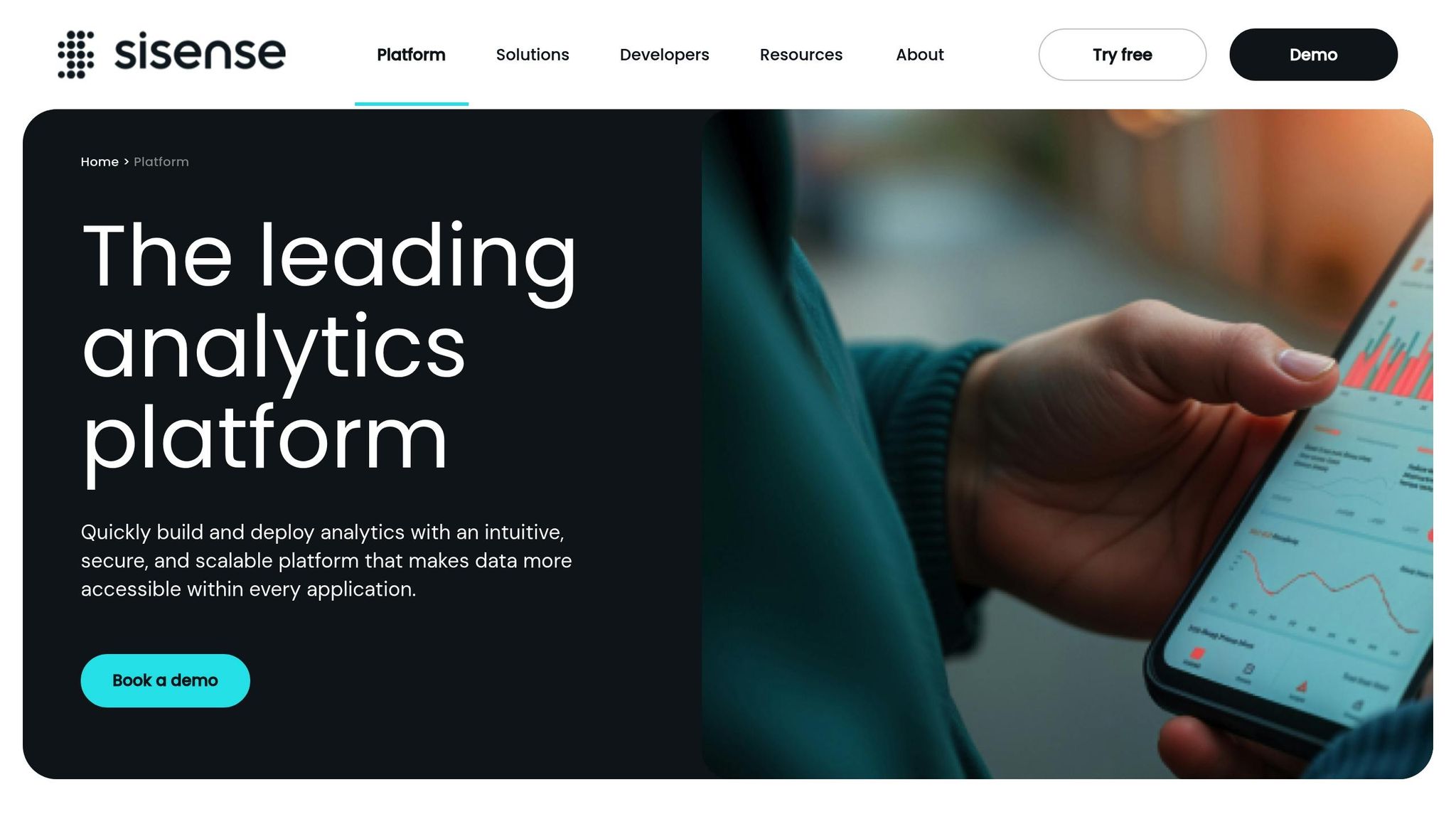
Sisense offers an AI-powered platform designed to turn complex data into clear, actionable insights in real time. Let’s dive into how its real-time capabilities and features deliver exceptional results across industries.
Real-Time Analytics Performance
Sisense's live models enable instant querying of data sources, providing real-time updates. This ability has led to impressive outcomes in various sectors:
| Industry | Organization | Results |
|---|---|---|
| Sports | USA Swimming | Delivered insights 20x faster to 400K users |
| Nonprofit | Funraise | Saved 40 hours weekly, increased fundraising 7x |
| Technology | Bigtincan | Achieved 215% ROI and cut support needs by 90% |
Integration Capabilities
Sisense stands out with its extensive integration options, making it easy to connect to a wide variety of data sources:
- Over 400 data connectors
- Compatibility with databases, spreadsheets, and cloud services
- Tools like REST APIs and Compose SDK for custom development
"We're trying to enable our teams and coaches around the country to think in new ways and to look at data in different ways, and Sisense is helping us to do that."
Enterprise-Grade Features
Sisense also delivers enterprise-level scalability and security, ensuring businesses can adapt quickly without compromising safety. Devin Vyain, Senior Solutions Architect at Barrios Technology, highlighted this advantage:
"We went from custom application development to the ability to rapidly change something on the dashboard and then publish it again in real-time within the production environment - without sacrificing any of the security. That really helped us level up."
Future-Ready Analytics
The growing need for embedded analytics underscores Sisense's relevance:
- 80% of organizations view embedded analytics as essential for future success
- 53% predict AI-assisted workflows will handle more than half of their operations by 2026
- Businesses expect a median impact of $500,000 to $1 million through increased efficiency and revenue
Sisense excels in handling intricate data setups. For example, Skullcandy successfully unified over 100 million data rows from multiple sources, dramatically improving data accuracy and accessibility across its departments. This capability makes Sisense a valuable tool for companies navigating complex data challenges.
4. Qlik Sense

Qlik Sense uses its QIX Engine and Associative Data Model to deliver real-time insights. With a customer base exceeding 40,000 worldwide, the platform has proven its value across numerous industries and applications. Let’s take a closer look at the architecture that powers these capabilities.
Real-Time Analytics Architecture
At the heart of Qlik Sense is its high-speed, in-memory QIX engine, which dynamically connects data to enable rapid analysis. This architecture provides several key benefits:
| Feature | Business Impact |
|---|---|
| Associative Data Model | Simplifies data exploration and uncovers hidden insights |
| Real-time Data Pipeline | Automates actions based on live data |
| AI-powered Analysis | Delivers contextual insights and predictive capabilities |
This robust analytics engine is designed to handle enterprise-level demands while maintaining speed and efficiency.
Enterprise-Scale Solutions
Qlik Sense supports scalability with subscription options tailored to enterprise needs. These range from 5 GB to 50 GB and include plans like Enterprise SaaS, Analytics Premium, Analytics Enterprise, and Large App Support.
Success Stories
Organizations around the globe have used Qlik Sense to revolutionize their operations. For example:
- Honda: Deployed the platform to 7,000 users, leading to reduced production costs and better decision-making.
- Lenovo: Transitioned from reactive to proactive analytics for improved business outcomes.
Advanced Visualization Capabilities
-
Interactive Dashboards: Mobile-friendly dashboards help businesses make decisions in real time. A notable example is Samsung retail:
"Real-time data and alerting on mobile equips Samsung retail to make sure we're not focusing on noise and only on actionable insights."
- Intelligent Alerting: Automated alerts ensure immediate responses to business-critical events. For instance, KFC Europe uses these features to maintain constant visibility into their performance.
These visualization tools allow businesses to stay agile and act quickly when data trends shift.
Integration Framework
Qlik Sense also excels in embedding analytics into existing workflows, enabling seamless integration. Moody's Analytics, for example, has leveraged the platform to enhance customer service. Mehna Raissi, Senior Director of Enterprise Risk Solutions, shared:
"Qlik Sense simplifies our ability to provide the highest level of customizable insights to our customers, allowing them to view portfolio metrics quickly, compare benchmarks and adapt our evolving society."
With its scalable architecture, real-time analytics, and advanced visualization tools, Qlik Sense empowers organizations to make fast, informed decisions and stay ahead in a data-driven world.
sbb-itb-5174ba0
5. Tableau
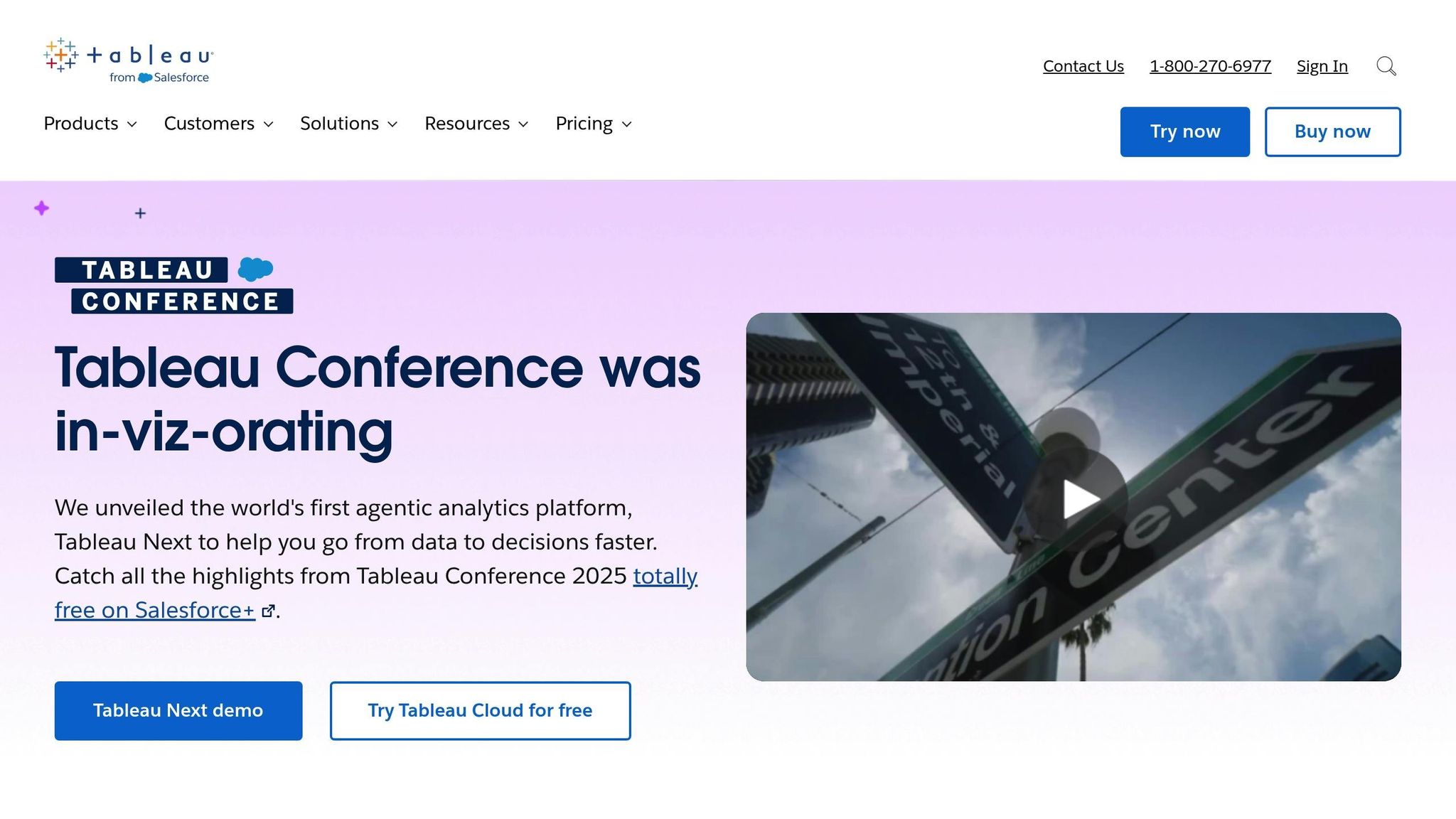
Tableau provides businesses with the ability to gain insights in real time by connecting directly to diverse data sources, enabling swift and informed decision-making.
Real-Time Data Architecture
With Tableau, visualizations are always up-to-date, thanks to its direct connection to data sources. This ensures that the latest information is instantly reflected in dashboards and reports. The platform is compatible with a wide variety of cloud-hosted and enterprise data sources, such as:
| Enterprise Data Sources | Cloud Services |
|---|---|
| Microsoft SQL Server | Amazon Redshift |
| SAP HANA | Google BigQuery |
| PostgreSQL | Snowflake |
| HP Vertica | Amazon Aurora |
| MySQL | Microsoft Azure SQL |
Performance Optimization
Tableau offers flexible options to optimize performance while maintaining real-time updates:
- Live Connections: Best for scenarios requiring immediate updates.
- Data Extracts: Ideal for handling large datasets and creating complex visualizations.
- Hybrid Approach: Combines live connections and extracts, tailored to specific use cases.
These options allow users to balance speed and efficiency based on their analytical needs.
Advanced Integration Capabilities
Tableau’s Analytics Extensions API enables integration with Python and R, unlocking advanced analytical possibilities. Its scalability has made it a preferred tool for companies like Juniper Networks, which adopted the platform in 2024.
Flexible Pricing Structure
Tableau’s pricing adapts to businesses of all sizes, offering subscription levels to meet varying needs:
| Subscription Level | Monthly Cost per User |
|---|---|
| Viewer | $15 |
| Explorer | $42 |
| Creator | $75 |
This tiered structure ensures that organizations can scale their investment as they grow.
"Tableau has become a part of our real-time actionable insights offering, which provides brands with a direct mobile channel to consumers. Tableau helps us learn about their behavior, and we provide consumers with targeted personalized offers based on these real-time learnings."
- Graham Halling, Commercial Director, Shopitize
The platform’s ability to boost insights-driven decision-making by 33% highlights its value in empowering organizations to make smarter, data-backed choices in real time.
6. Looker Studio (Google)
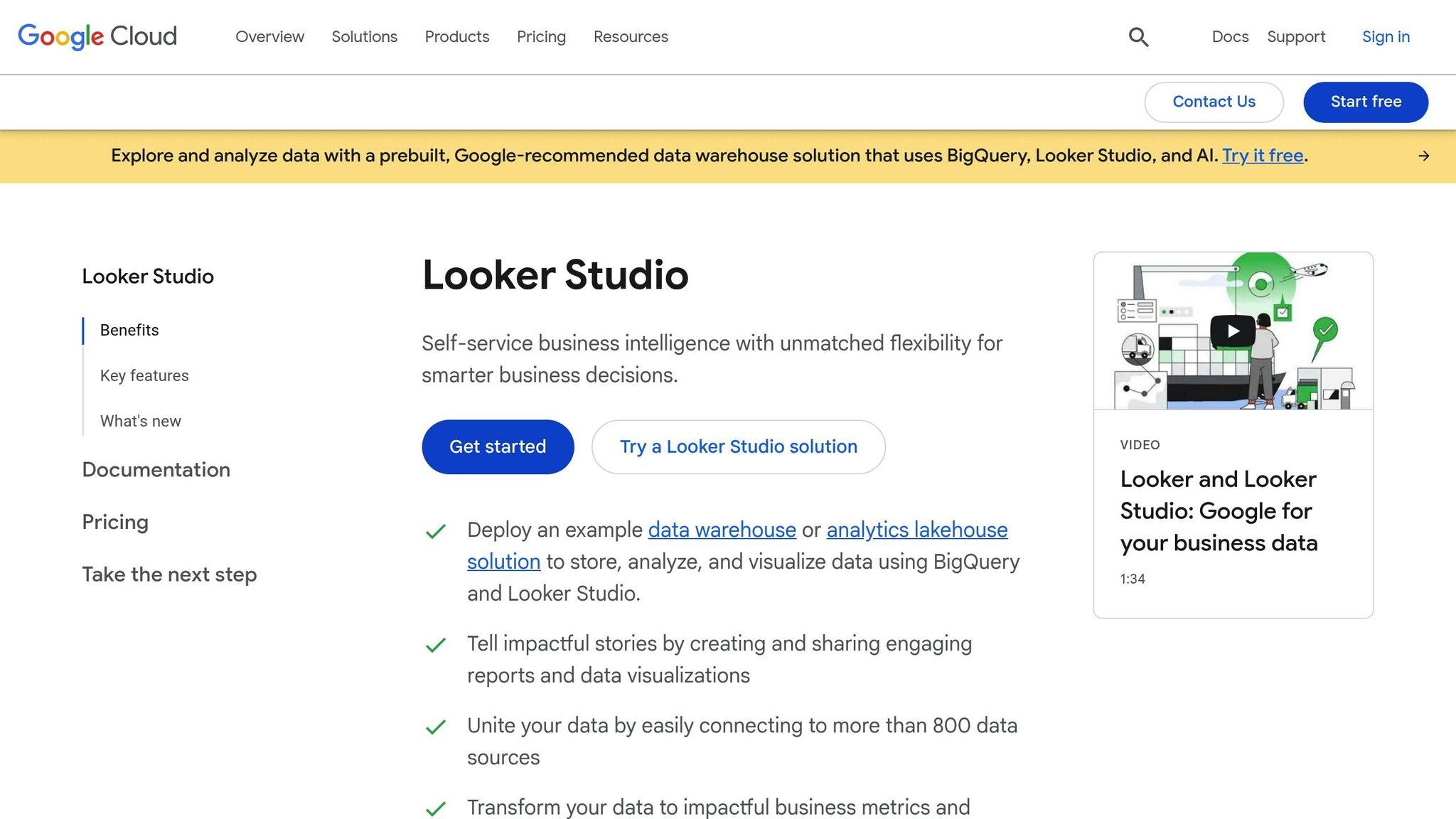
Looker Studio is a cloud-based BI platform designed to transform raw data into meaningful insights through interactive dashboards and real-time reporting.
Real-Time Data Integration
Looker Studio connects effortlessly to nearly 1,000 built-in data sources. These include:
- Google Services: Analytics, Ads, BigQuery, Cloud SQL
- Marketing Platforms: Facebook, Twitter, email tools
- Databases: SQL, PostgreSQL, MySQL
- File Formats: CSV files, spreadsheets
This broad compatibility allows users to integrate data from various sources for a comprehensive view.
Advanced Visualization Features
Looker Studio enables users to create interactive dashboards with features like filters, date range controls, customizable charts, and dynamic updates. It also supports custom metric calculations, making it easier to tailor reports to specific needs.
Flexible Pricing Options
Looker Studio offers a pricing model that suits different user needs:
| Service Level | Monthly Cost per User |
|---|---|
| Self-service BI | Free |
| Pro (Project subscription) | $9 per user per project per month |
This tiered structure ensures affordability for both individual users and larger teams.
Real-World Application
One example of Looker Studio in action is InPulse Digital, which uses the platform to automate paid media reporting. This allows them to track campaigns in real time and make instant updates.
Enterprise Integration Capabilities
The platform is fully integrated with Google Cloud infrastructure, supporting real-time analytics, API connections, automated data refresh, and multi-user collaboration. It’s especially useful for organizations already using Google services, as it provides seamless data integration and instant performance insights.
For marketing teams and Google-centric businesses, Looker Studio stands out as a user-friendly tool for real-time analytics and data visualization.
7. Zoho Analytics
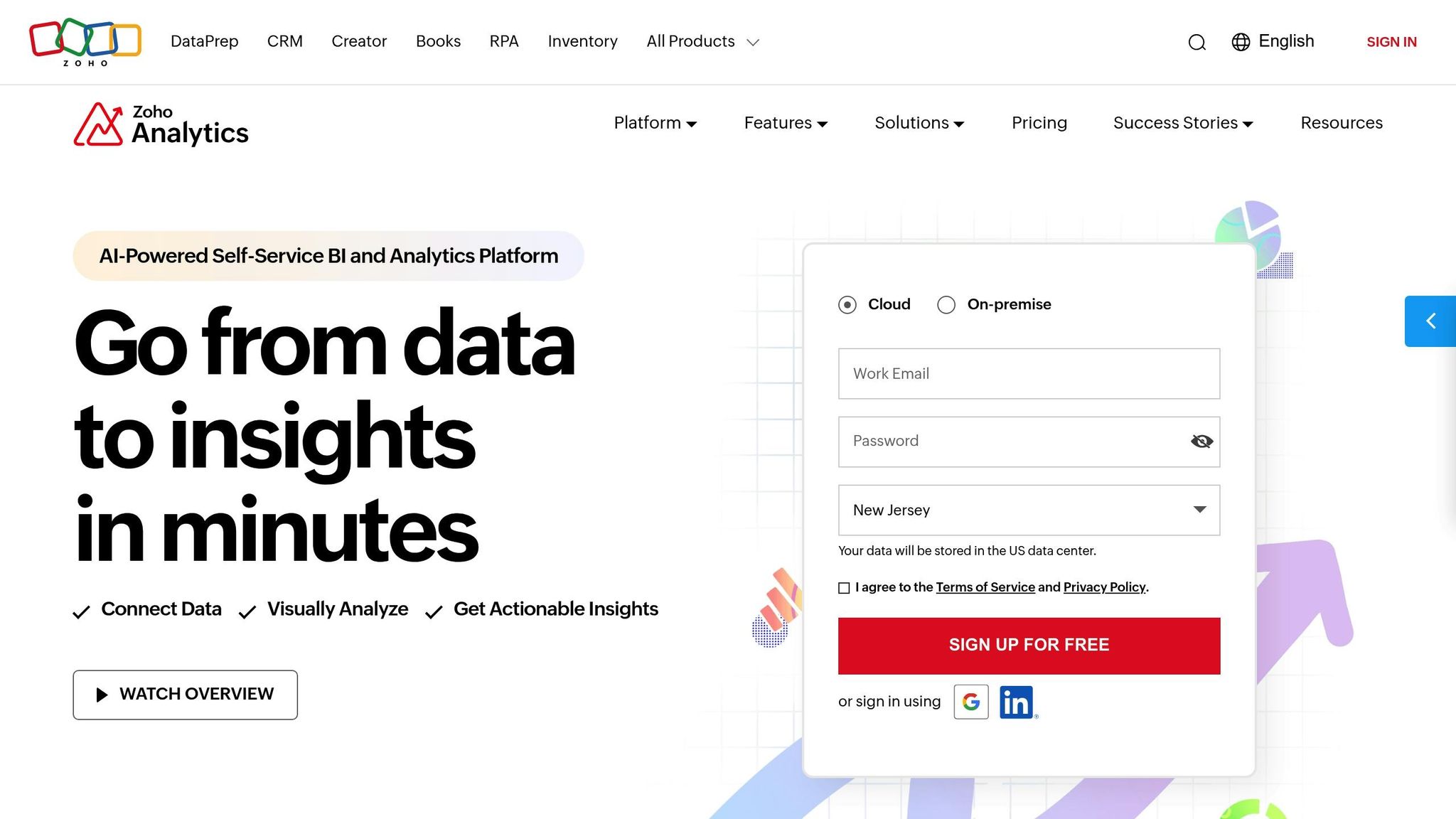
Zoho Analytics stands out as a reliable option among BI tools for real-time decision-making, offering a mix of powerful features and user-friendly functionality.
Real-Time Data Processing
With its Live Connect feature, Zoho Analytics runs queries directly on source databases. This means you get real-time, precise reports without the need for data storage.
Integration Capabilities
Zoho Analytics connects seamlessly with a wide range of platforms, ensuring smooth data flow across systems:
| Data Source Type | Available Connections |
|---|---|
| Cloud Services | Zoho WorkDrive, Google Drive, OneDrive, Box, Dropbox, Amazon S3 |
| Databases | MySQL, SQL Server, Oracle, PostgreSQL, Amazon RDS, Amazon Redshift |
| Business Apps | Salesforce CRM, Microsoft Dynamics CRM, HubSpot CRM, QuickBooks |
| Zoho Suite | Zoho CRM, Books, Billing, Inventory, Forms |
Pricing Structure
Zoho Analytics offers flexible pricing options to accommodate businesses of all sizes:
| Plan Level | Monthly Cost | Max. Users | Data Rows |
|---|---|---|---|
| Always Free | $0 | 2 | 10,000 |
| Basic | $30 | 2 | 500,000 |
| Standard | $60 | 5 | 1,000,000 |
| Premium | $145 | 15 | 5,000,000 |
| Enterprise | $575 | 50 | 50,000,000 |
Real-World Success Stories
"We chose Zoho Analytics for its robust integration and the powerful Zia Insights, which cut reporting time from 2 days to minutes and boosted revenue by 5%." - Alun Rafique, CEO & Co-founder, Market Dojo UK
One manufacturing company uses Zoho Analytics to track supplier performance and production timelines in real time. By identifying bottlenecks as they happen, the company resolves delays before they disrupt operations, keeping workflows smooth and efficient.
Performance Metrics
Zoho Analytics has earned the trust of its users, with 91% recommending it, 79% expressing satisfaction, and more than 20,000 businesses relying on its capabilities.
For businesses aiming to gain real-time insights without diving into complex coding, Zoho Analytics delivers a practical and powerful solution. Its ability to connect directly to data sources ensures accuracy, while its intuitive interface transforms raw data into actionable insights. This makes it an essential tool for companies looking to stay ahead in today’s fast-paced environment.
BI Tools Feature Comparison
After examining the specifics of each tool, here's a closer look at how they stand out in different areas.
Real-Time Processing Capabilities
| Tool | Real-Time Features | Data Processing Speed | Key Strength |
|---|---|---|---|
| Domo | Real-time dashboards on any device | Cloud-native architecture | Over 1,000 prebuilt connectors |
| Microsoft Power BI | Interactive live dashboards | Optimized for Microsoft ecosystem | Extensive data source connectivity |
| Sisense | In-chip processing engine | High-speed handling of large datasets | Complex data processing |
| Qlik Sense | Associative data model | Free-form data exploration | No predetermined queries |
| Tableau | Live data visualization | Drag-and-drop interface | Real-time analysis |
| Looker Studio | On-the-fly querying | Integration with big data infrastructures | No data extraction needed |
| Zoho Analytics | Real-time data connectivity | Efficient performance | Self-service data preparation |
Integration Landscape
Seamless integration across platforms is a hallmark of modern BI tools. Studies suggest that well-integrated data analytics can speed up decision-making processes by up to five times.
| Tool | Cloud Services | Databases | Business Apps | Notable Feature |
|---|---|---|---|---|
| Domo | 1,000+ | Yes | Yes | Largest connector suite |
| Power BI | Microsoft-focused | Yes | Limited | Best within Microsoft stack |
| Sisense | Extensive | Yes | Yes | Embedded analytics |
| Qlik Sense | Moderate | Yes | Yes | Associative engine |
| Tableau | Extensive | Yes | Yes | Visual-first approach |
| Looker Studio | Google-focused | Yes | Limited | Native cloud integration |
| Zoho Analytics | Moderate | Yes | Yes | Built-in ETL |
Pricing Structure Comparison
The BI industry is expected to grow to $33 billion by 2025. Here's how the pricing of popular tools stacks up:
| Tool | Starting Price (per user) | Team Cost (1 admin + 10 users) | Enterprise Features |
|---|---|---|---|
| Microsoft Power BI | $10 | $154 | Quote-based |
| Tableau | $75 | $420 | Volume discounts |
| Qlik Sense | $30 | $330 | Quote-based |
| Domo | Quote-based | Quote-based | All-inclusive |
| Sisense | Quote-based | Quote-based | Embedded analytics |
| Looker Studio | Quote-based | Quote-based | Premium support |
| Zoho Analytics | $30 | Quote-based | Advanced features |
Performance Considerations
"Data integration enables you to easily access all of the data you need to make informed business decisions and allows you to transform and combine data sources for accurate analysis." – Domo
The BI tool you choose can significantly influence real-time decision-making. Tools like Domo and Power BI shine with their live dashboard capabilities, while Sisense's in-chip processing engine is ideal for handling complex datasets. For organizations focusing on dynamic data visualization, Tableau offers a standout visual-first approach, and Qlik Sense supports exploratory analysis through its associative model.
As the trend toward cloud-native designs grows, tools like Domo and Looker Studio are well-positioned to deliver flexibility and adaptability for future needs. These comparisons provide a clear path to identifying the right tool for your business.
Next Steps
Choosing the right BI tool for your organization starts with a clear understanding of your needs. Here's how to approach the process effectively:
Evaluate Your Requirements
Start by identifying the specific business questions each department needs answers to. For instance, your sales team might prioritize real-time tracking of conversion rates, while marketing may focus on campaign performance insights. It's also important to consider your team's technical skills and how they handle data workflows. The goal is to align the tool's capabilities with your team's expertise and operational needs.
Technical Assessment Checklist
Use this checklist to guide your technical evaluation:
| Consideration | Key Questions | Impact on Decision |
|---|---|---|
| Data Integration | What systems need to connect? | Affects how quickly you can implement the tool. |
| User Expertise | How tech-savvy is your team? | Determines the level of training required. |
| Scalability | How much will your data grow in a year? | Helps anticipate future costs and performance needs. |
| Mobile Access | Do teams need analytics on the go? | Influences the type of licensing you’ll need. |
"BI and analytics tools are not standalone entities; they must integrate and operate in harmony with all the software and tooling you have behind it." - Analytics8
Implementation Strategy
Before making your final decision, take these steps to ensure the tool meets your expectations:
- Test it using your actual business data.
- Check data response times to ensure they meet your needs.
- Evaluate collaboration features to see how well teams can share insights.
- Review the full pricing structure, including any potential hidden fees.
For a deeper dive into BI tools, visit the Marketing Analytics Tools Directory. It offers detailed comparisons and pricing information to help you make a well-informed choice.
Finally, remember that your BI tool is only as good as the data it works with. Keep your data clean and establish clear governance processes to get the most out of your investment.
FAQs
What should I look for in a BI tool to make real-time decisions for my business?
When selecting a Business Intelligence (BI) tool for real-time decision-making, it's essential to focus on a few critical factors that align with your organization's goals. Start by prioritizing tools with real-time data processing capabilities. This feature enables you to react swiftly to changes and make informed decisions as events unfold.
Another key consideration is the tool's ability to integrate smoothly with your existing data sources. This ensures you can analyze both internal and external data without unnecessary complications. Additionally, a user-friendly interface is vital, as it allows team members of varying technical expertise to adopt and use the tool effectively. Lastly, think about the tool's scalability - you'll want a solution that can adapt to your business's growth and handle increasing data volumes over time.
How do integration features improve the effectiveness of BI tools for real-time decision-making?
Integration features are essential for boosting the performance of business intelligence (BI) tools, especially when it comes to making real-time decisions. By connecting effortlessly to a variety of data sources - like databases, cloud services, and IoT devices - these tools bring all the information together into a single, cohesive view. This consolidation helps businesses gain quicker and more precise insights.
Unlike traditional systems that process data in batches, real-time BI tools work continuously, ensuring insights are always current. This constant data flow allows businesses to respond promptly to market shifts, streamline operations, and tackle issues as they emerge. Features such as dynamic dashboards and automated alerts add even more agility, making integration capabilities a key element in the success of modern BI tools.
How do pricing models for BI tools impact scalability for growing businesses?
The way business intelligence (BI) tools are priced can play a big role in how easily they scale, especially for businesses that are expanding. Common pricing models include per-user subscriptions, tiered plans based on features, and one-time licensing fees. For instance, Microsoft Power BI offers options like the Pro plan at $10 per user per month and the Premium Per User plan at $24 per month. This makes it a practical choice for both small teams and larger enterprises.
One of the standout benefits of many BI tools is their ability to scale. Flexible pricing structures mean companies can increase their usage as their data needs grow, without breaking the bank. Tools like Qlik Sense and Looker are often highlighted for their scalability, ensuring businesses can keep using data insights effectively as they expand.


